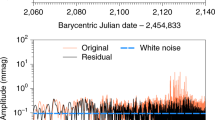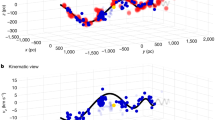Abstract
Arising from: J. M. Matthews et al. Nature 430, 51–53 (2004) Stars are spheres of hot gas whose interiors transmit acoustic waves very efficiently. Geologists learn about the interior structure of Earth by monitoring how seismic waves propagate through it and, in a similar way, the interior of a star can be probed using the periodic motions on the surface that arise from such waves. Matthews et al. claim that the star Procyon does not have acoustic surface oscillations of the strength predicted1. However, we show here, using ground-based spectroscopy, that Procyon is oscillating, albeit with an amplitude that is only slightly greater than the noise level observed by Matthews et al. using spaced-based photometry.
Similar content being viewed by others
Main
The new spectrograph HARPS2 (for High-accuracy Radial-velocity Planet Searcher), which was installed last year on the 3.6-metre telescope of the European Southern Observatory (La Silla, Chile), was optimized for accuracy in Doppler measurement in order to detect extrasolar planets by means of radial-velocity measurements. During its commissioning, we tested its short-time precision on a sample of bright solar-type stars, including Procyon.
Our measurements on Procyon indicate that there are periodic oscillations of its surface that have a typical period of 18 min (Fig. 1). The apparent amplitude of 4–6 m s−1 does not correspond to individual p-mode amplitudes, considering that several tens of p-modes with similar periods are presumably interfering. Figure 2 presents the Fourier amplitude spectra of the two short time-series obtained on Procyon. No filtering has been applied to the data. Several peaks appear between 0.5 and 1.5 mHz and present the clear signature of acoustic oscillation modes. The correspondence of the main peaks around 1 mHz strongly support the reality of this signature.
Our frequency resolution, which is about 0.55 mHz, does not allow us to resolve individual p-modes. The amplitudes of the peaks between 1.0 and 1.5 m s−1 probably correspond to two or three times the amplitude of individual modes. The mean white-noise level above 2 mHz is respectively 0.11 m s−1 and 0.09 m s−1 for the first and second sequences. This result, based on only a few hours of observations, confirms and enforces the previous Doppler ground-based detections3,4,5,6.
Why did the Canadian MOST (for Microvariability and Oscillations of Stars) space mission1 not detect any signatures of p-modes on Procyon? The typical amplitude of p-modes is about 0.5 m s−1 in radial velocity and the relation for converting between velocity and luminosity amplitudes (given by equation (5) of ref. 7) predicts a luminosity amplitude of only 8–10 p.p.m. This is only slightly greater than the noise level of the satellite obtained after 768 hours of observation. These results indicate that the MOST data are dominated by non-stellar noise, as suspected8.
However, this conclusion should not overshadow the scientific importance of the Canadian satellite. MOST will lead to breakthroughs on stars with higher oscillation amplitudes, as well as on fast-rotating stars that are not suitable for spectroscopic measurement. The result obtained with HARPS demonstrates the potential of ground-based Doppler measurements for asteroseismology. But for uninterrupted listening to stellar music, a spectrograph like HARPS located in Dome C in Antarctica or in space is needed.
References
Matthews, J. M. et al. Nature 430, 51–53 (2004).
Mayor, M. et al. The Messenger 114, 20–24 (2003).
Brown, T. M., Gilligand, R. L., Noyes, R. W. & Ramsey, L. W. Astrophys. J. 368, 599–609 (1991).
Martic, M. et al. Astron. Astrophys. 351, 993–1002 (1999).
Martic, M., Lebrun, J. -C., Appourchaux, T. & Korzennick, S. G. Astron. Astrophys. 418, 295–303 (2004).
Eggenberger, P., Carrier, F., Bouchy, F. & Blecha, A. Astron. Astrophys. 422, 247–252 (2004).
Kjeldsen, H. & Bedding, T. R. Astron. Astrophys. 293, 87–106 (1995).
Christensen-Dalsgaard, J. & Kjeldsen, H. Nature 430, 29–30 (2004).
Author information
Authors and Affiliations
Corresponding author
Rights and permissions
About this article
Cite this article
Bouchy, F., Maeder, A., Mayor, M. et al. Oscillations on the star Procyon. Nature 432, 2 (2004). https://doi.org/10.1038/nature03165
Published:
Issue Date:
DOI: https://doi.org/10.1038/nature03165
This article is cited by
-
Asteroseismology of solar-type stars
Living Reviews in Solar Physics (2019)
-
Theoretical prediction of chromospheric oscillations in late-type stars
Astrophysics and Space Science (2016)
Comments
By submitting a comment you agree to abide by our Terms and Community Guidelines. If you find something abusive or that does not comply with our terms or guidelines please flag it as inappropriate.





